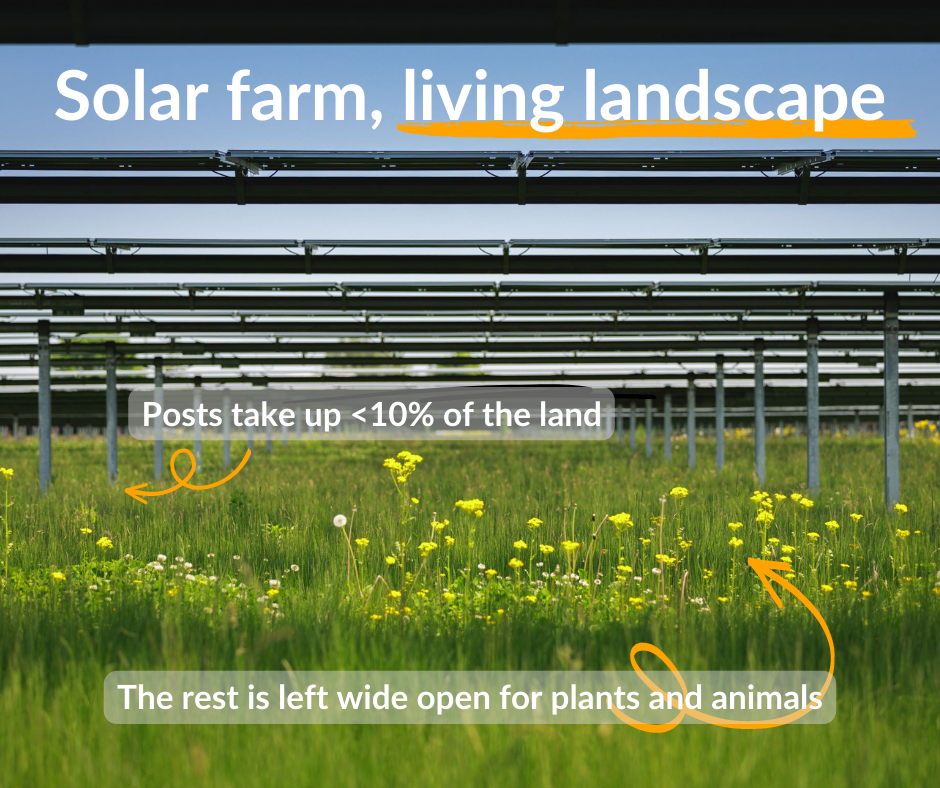Our plans to create and preserve native Louisiana habitat at Prairie Ronde Solar
Permanent development of our lands is causing habitat and biodiversity loss. This is threatening many plants and animals that humans depend on.
Solar farm development is different, however. Solar farms temporarily set aside land and protect it from permanent loss due to industrialization and urbanization. Vegetation grows across more than 90% of a typical solar farm, creating a green carpet under and around the solar panels. Therefore, solar farms can generate energy for people while at the same time providing a great home for plants and wildlife.

Lightsource bp has a commitment to increase biodiversity (the variety of living species) on our solar farms within 5 years post-construction. At our Prairie Ronde Solar farm in St. Landry Parish, we consulted with local experts, including the U.S. Fish and Wildlife Service Partners in Wildlife, on how to achieve this goal. Keep reading to learn about three ways we are creating natural habitat at the solar farm.
1. Creating and preserving diverse habitat under and around the solar panels
The Prairie Ronde Solar farm has created an opportunity to improve biodiversity on the land, by growing a variety of beneficial plants under and around the solar panels. Working with the U.S. Fish & Wildlife Service, we have selected a dozen different seeds to sow across the site. The seed mix contains multiple native grasses and forbs (small, non-woody flowering plants), as well as cover crops, which will help stabilize the site and improve soil quality.
Plant species that are native to the area are adapted to the local climate, meaning they thrive without inputs like fertilizers. The Prairie Ronde seed mix contains four grasses native to Louisiana, which will provide critical habitat to insects, birds and other Louisiana wildlife.
Six flowering forbs will also grow under and around the panels at Prairie Ronde Solar. These seeds were selected for their soil health properties and habitat value. These flowers will provide nectar, pollen and seeds as a food source for a variety of birds, mammals and insects, including those that pollinate human food crops.
2. Restoring native Coastal Prairie
Prior to human settlement, 2.5 million acres of coastal prairie stretched across southwestern Louisiana. This ecosystem was home to an extremely diverse mix of native plants and animals. Less than 1% of this imperiled landscape remains today, scattered in small patches across the region.
Lightsource bp has dedicated an area of the Prairie Ronde solar farm to restoring coastal prairie habitat. We are working with local experts, including the Fish & Wildlife Service Louisiana Ecological Services Field Office, to re-establish characteristic coastal prairie plants on 12 acres outside of the solar array. This area, still under development, could provide a home to hundreds of diverse plant and animal species.
3. Protecting Eastern Bluebirds through community partnership
Eastern Bluebirds are common in Louisiana. But did you know that they nearly went extinct in the early 1900s?
Eastern bluebirds make their nests in abandoned holes dug by larger birds. So do House Sparrows and European Starlings, two non-native bird species introduced to the United States by human activity. The more aggressive sparrows and starlings took over the nesting cavities, leaving the Eastern Bluebird nowhere to lay its eggs.
Fortunately, concerned humans were able to help. Conservation groups began putting up artificial nesting boxes specifically for the Eastern Bluebird, and the population bounced back.
Lightsource bp plans to play a small role in continuing to protect the Eastern Bluebird, but we need your help! We are seeking local partners like schools, scout troops and conservationists to help build, install and care for Eastern Bluebird boxes around the perimeter of the Prairie Ronde project. If you are interested in helping out, please contact USCommunityRelations@lightsourcebp.com.
See more Responsible Solar stories from Lightsource bp
03 Apr, 2025
Community hospital check presentation, job fair kick off Lightsource bp Jones City energy center in Jones County, Texas
Community partnerships in Texas
19 Feb, 2025
Video: Honeysuckle Solar drives American manufacturing close to home
Indiana project includes locally manufactured parts



